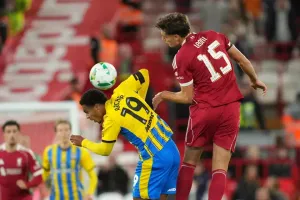When the news broke that Giovanni Leoni had suffered a ruptured anterior cruciate ligament (ACL) in his left knee, the sense of deflation was palpable. The young centre-half, touted as one of European football’s brightest defensive prospects, now faces the kind of injury that has derailed or reshaped countless careers before his. For Leoni, whose progress seemed unstoppable, the diagnosis was devastating: season-ending, and potentially career-altering.
ACL tears are among the most dreaded words in football. They carry with them not just the physical challenge of surgery and rehabilitation, but the psychological toll of months on the sidelines, watching teammates battle while the injured player is consigned to the gym, the treatment room, and lonely training sessions. Yet in 2025, ACL recovery science is better understood than ever before. For Leoni, the path is difficult, but it is also navigable.
🚨⚠️ Liverpool centre back Giovanni Leoni has torn his ACL and will be out for several months.
— Fabrizio Romano (@FabrizioRomano) September 24, 2025
After excellent debut in League Cup last night with also Arne Slot very happy, an unlucky injury for Leoni who will try to be back before the end of the season. pic.twitter.com/TWFvj5jKfY
The Anatomy of an ACL Tear
The anterior cruciate ligament is one of the knee’s key stabilizers, connecting the femur (thigh bone) to the tibia (shin bone). It prevents the knee from giving way during sudden pivots, cuts, or landings — movements that define elite football.
Leoni’s injury, like so many in football, came during a moment of sharp movement. The ACL does not always need contact to tear. In fact, roughly 70% of ACL injuries in sport are non-contact, often triggered by deceleration, pivoting, or awkward landings (Griffin et al., J Bone Joint Surg Am, 2006).
Scans confirmed the worst for Leoni. A full rupture. Surgery is inevitable. And with it, months of rehabilitation.
The Numbers Behind the Injury
ACL tears are not rare in professional football. According to the UEFA Elite Club Injury Study, ACL injuries account for around 2% of all reported injuries, but are among the most severe in terms of time lost (Ekstrand et al., Br J Sports Med, 2021).
- Recovery timelines: Most players return between 6–12 months after reconstruction surgery, though performance may continue to improve up to 18–24 months post-injury (Nagelli & Hewett, Br J Sports Med, 2017).
- Reinjury rates: Around 15% of athletes suffer another ACL injury, either to the repaired knee or the opposite one, within two years (Wiggins et al., Am J Sports Med, 2016).
- Return to pre-injury levels: Only about 65% of athletes return to their pre-injury competitive level, and fewer still return to elite performance (Arundale et al., Br J Sports Med, 2018).
Age is a factor, too. Athletes under 25 have significantly higher rates of reinjury compared to older peers (Paterno et al., Am J Sports Med, 2012).
Echoes from the Past: Footballers Who Faced the Same Battle
Leoni is hardly the first promising defender to face this crucible. History provides a map — both inspiring and cautionary.
- Virgil van Dijk (Liverpool, 2020): After rupturing his ACL in a Merseyside derby, van Dijk missed the rest of the season. He returned in nine months and re-established himself as one of the world’s best defenders, though it took nearly a full year for his explosiveness to return.
Information on Virgil van Dijk is that he’s done his ACL which would keep him out for the best part of 7-8 months. [BeINSports] pic.twitter.com/EvyhlKW6aL
— Anfield Edition | æ (@AnfieldEdition) October 17, 2020
- Alessandro Florenzi (Roma, 2016): Suffered two ACL ruptures in the same knee within a year. Though he returned, he was never quite the same dynamic full-back, adapting to new roles.
Confirmed: Alessandro Florenzi has torn the same ACL just 4 months later.
— Serie A News (@TransfersCalcio) February 17, 2017
He will undergo surgery today and his season is over. pic.twitter.com/dw7qsSNn2Q
- Federico Chiesa (Juventus, 2022): Spent nearly 12 months sidelined. His reintegration was cautious, with reduced minutes to guard against reinjury.
🚨 Italy’s ACL CURSE 🚨
— Carlo Garganese (@carlogarganese) September 24, 2025
Giovanni Leoni 🏥
Chiesa 🏥
Zaniolo x2 🏥
Scalvini 🏥
Scamacca 🏥
Chiesa & Zaniolo WERE generational talents before ACLs
Leoni IS (was?) generational
Is Italy cursed or are our training methods to blame?
These ACLs have destroyed a whole 🇮🇹 generation pic.twitter.com/gtH5wHuF9g
For every player who comes back stronger, there are those whose careers shift direction. What unites them all is the grueling process that lies between surgery and comeback.
Inside the Recovery Process
Recovery from an ACL rupture unfolds in phases, each with its own benchmarks and risks.
- Pre-surgery (0–6 weeks)
Doctors often delay surgery until swelling subsides. “Pre-hab” — regaining range of motion and quadriceps strength before the operation — is associated with better outcomes (Eitzen et al., Br J Sports Med, 2009). - Surgical Reconstruction
The ACL is reconstructed using grafts: patellar tendon (BPTB), hamstring tendon, quadriceps tendon, or allografts. Graft choice influences reinjury risk: BPTB grafts may have slightly lower re-tear rates but higher donor site pain (Samuelsson et al., Knee Surg Sports Traumatol Arthrosc, 2009). - Early Rehabilitation (0–3 months)
Goals include restoring extension, reducing swelling, and activating quadriceps. Early range-of-motion exercises are crucial to avoid stiffness (Adams et al., J Orthop Sports Phys Ther, 2012). - Intermediate Phase (3–6 months)
Strength training and neuromuscular control dominate. Deficits in proprioception — the body’s sense of movement — are strongly linked to reinjury risk (Paterno et al., Am J Sports Med, 2010). - Return-to-Sport Training (6–9 months)
Athletes progress to sprinting, cutting, and plyometric drills. Passing functional hop tests and achieving >90% quadriceps strength symmetry compared to the uninjured leg are key clearance markers (Kyritsis et al., Br J Sports Med, 2016). - Full Return (9–12 months and beyond)
Research suggests delaying return to competition until at least 9 months post-surgery significantly reduces reinjury risk (Grindem et al., Br J Sports Med, 2016).
The Psychological Battle
Even when the body is “ready,” the mind may lag. Fear of reinjury is one of the biggest barriers to successful return (Ardern et al., Br J Sports Med, 2013).
Sports psychologists are increasingly embedded in recovery teams, helping players like Leoni rebuild trust in their movements through visualization, gradual exposure, and confidence-building drills.
Risks and Long-Term Outlook
Even with modern treatment, risks remain:
- Re-rupture: Most common within 2 years of return (Wiggins et al., 2016).
- Contralateral injury: Up to 20% of young athletes suffer an ACL injury in the opposite knee (Paterno et al., 2012).
- Arthritis: Long-term studies show 50% of ACL-injured athletes develop knee osteoarthritis within 10–15 years, especially if meniscus damage is present (Lohmander et al., Arthritis Rheum, 2007).
What It Means for Leoni
For Leoni, the immediate future is clear: surgery, followed by 9–12 months of structured rehabilitation. The club will likely be conservative, given his youth and the statistics on reinjury risk. His challenge will be not just physical recovery but resisting the temptation to rush back.
If his recovery is well-managed, his age could be an asset — younger athletes often regain strength and explosiveness more effectively. But the risk of reinjury will shadow his every step back to the pitch.
So gutted for this lad. He played so well tonight only to see his match end like that. Bashed his head when he fell, but the physios were clearly worried about his left knee too.
— LFC Memes For Fans Of The Worlds Greatest Team (@LFCMemesFFOTWGT) September 23, 2025
Could be a bad one, but hopefully better than it looked!
Get well soon Leoni. YNWA pic.twitter.com/5xNlNf54u7
A Career Paused, Not Ended
An ACL rupture is no longer the career death sentence it once was, but it remains a defining trial. For Giovanni Leoni, this is not the end of a promising career, but a pause. The next year will be a test of patience, discipline, and resilience.
If he follows the path of players like van Dijk, Chiesa, and others who returned to the highest level, he may yet transform this setback into an interlude rather than an ending. Football has seen this story before — and it has often ended in redemption.
Scientific Sources
- Griffin LY et al. J Bone Joint Surg Am. 2006. Mechanisms of noncontact ACL injury.
- Ekstrand J et al. Br J Sports Med. 2021. UEFA Elite Club Injury Study.
- Wiggins AJ et al. Am J Sports Med. 2016. Risk of secondary ACL injury.
- Arundale AJ et al. Br J Sports Med. 2018. Return to sport rates after ACLR.
- Paterno MV et al. Am J Sports Med. 2012. Reinjury risk in young athletes.
- Nagelli CV, Hewett TE. Br J Sports Med. 2017. Timeframe for RTS after ACLR.
- Kyritsis P et al. Br J Sports Med. 2016. RTS criteria and re-injury.
- Grindem H et al. Br J Sports Med. 2016. Return-to-sport timing and reinjury risk.
- Ardern CL et al. Br J Sports Med. 2013. Psychological readiness and RTS.
- Lohmander LS et al. Arthritis Rheum. 2007. Osteoarthritis after ACL injury.



